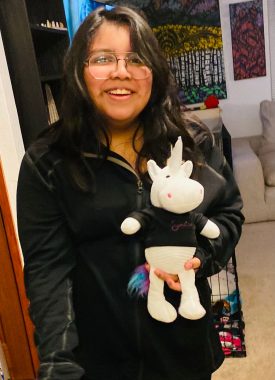Upcoming Research Gives Me Hope for the Future of Pediatric NMO
Written by |

In the five years since my daughter Bella, 14, was diagnosed with neuromyelitis optica (NMO), I have just barely come to accept that we may never know how or why she developed the disease. As Bella’s mom, I’ve spent countless sleepless nights filled with guilt and worry that something I did caused her to have NMO.
The unknowns of NMO can be tough to deal with for both patients and their caregivers — but there is hope.
Current treatment options
The U.S. Food and Drug Administration has approved three therapies for treatment of NMO in adults, but there currently aren’t any FDA-approved therapies specifically for children with NMO. This is understandable, as only 4% of NMO diagnoses occur in children, according to Children’s Health.
However, doctors may prescribe other medications to treat symptoms or prevent attacks. Bella has been receiving Rituxan (rituximab) twice a year since her diagnosis and, for the most part, has done well on it, remaining relapse-free.
Almost a year ago, though, her immunoglobulin G (or IgG, a type of antibody) levels dipped dangerously low, so she was placed on a monthly intravenous immunoglobulin (IVIG) infusion to raise them. Bella’s new infusion is working to raise her IgG level, but the IVIG sometimes causes her to have debilitating migraines.
There is no cure for NMO yet, which causes me a great deal of stress and concern as Bella’s mom. My biggest questions are: What does the future look like for a child with NMO? And will treatments prove sustainable for patients in the long term?
These questions have yet to be answered, but thanks to research efforts, I am optimistic about the future for pediatric NMO patients, or “unicorns,” as we lovingly refer to them.

Bella holds a unicorn gifted to her by The Sumaira Foundation — a reminder that like a unicorn, she is rare. (Photo by Candice Galvan)
Funding grants available
Over the years, our community has celebrated multiple advancements in research and treatments, made possible in part by funding grants awarded by nonprofits such as The Sumaira Foundation (TSF).
I was recently excited to see that the TSF grants program is now accepting applications for research grants (up to $25,000 each), which will be awarded to “nonprofit organizations, researchers, and/or institutions engaged in research into prevention, treatments, and a cure(s) for neuromyelitis optica spectrum disorder (NMOSD) and myelin oligodendrocyte glycoprotein antibody disease (MOG-AD).”
The international community is invited to apply for two types of grants: SPARK grants fund adult NMO/MOG-AD research, while Joannie’s Unicorn Grant, established in March 2019 in honor of a young patient who passed away from the disease, funds pediatric research. Last year, TSF awarded four SPARK grants, and the Unicorn grant went to Nusrat Ahsan, MD, at the Children’s Hospital of Los Angeles.
Even though there is so much more to discover about NMO, I know that the world’s best doctors, researchers, patients, caregivers, and advocates are working hard to illuminate the darkness. It is my hope that the future will bring more research about children with NMO, as well as the long-term effects of treatment. And I’m confident that if we all work together, one day we’ll be celebrating a cure.
Until then, I commit to doing all I can as a mom and a caregiver to Bella. With help from our precious NMO community, I’ll ensure she lives the best life possible.
Note: Neuromyelitis News is strictly a news and information website about the disease. It does not provide medical advice, diagnosis, or treatment. This content is not intended to be a substitute for professional medical advice, diagnosis, or treatment. Always seek the advice of your physician or other qualified health providers with any questions you may have regarding a medical condition. Never disregard professional medical advice or delay in seeking it because of something you have read on this website. The opinions expressed in this column are not those of Neuromyelitis News or its parent company, Bionews, and are intended to spark discussion about issues pertaining to neuromyelitis optica spectrum disorder (NMOSD).







Leave a comment
Fill in the required fields to post. Your email address will not be published.